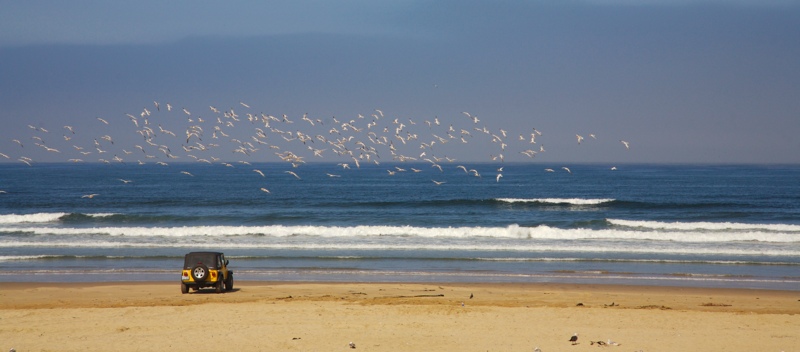The decisive moment exists in landscape pictures too.
Working on my beach series yesterday I was rambling along Grover Beach and idly eyeing the yellow Jeep wondering if something could be crafted aound it. True, I had noted a flock of some two hundred or so Common Tern minding their own business on the dunes nearby, but thought nothing of it. Fish eaters, these, so likely pretty smart, what with fish being so good for the grey matter. Known to attack marauding humans, too, so I kept my distance. A lovely bird – pure white with a jet black head and yellow beak. Quite the designer’s dream.
I am not, as a rule, the type who composes in the viewfinder, preferring to visualize the scene with my (not so great) eyes then administering the coup de grace with a quick raising of the camera to eye level and a pressing of the button. A legacy of years of street photographing, I suppose. Auto focus and exposure makes that approach even easier than in days of yore.
I found myself wondering about the tranisent lighting effects that can so quickly change a landscape. The times when the clouds open just so and you miss the shot because of some malfunction with the tripod. Landscapes are anything but static subjects.
But this one was, let’s face it, not going anywhere. The waves were rolling in on a fairly predictable schedule and the jolly yellow Jeep was parked. So I just sort of stood there, taking in the view on yesterday’s cool morning, glad I had remembered to pack my wool pullover, for it was but 58 degrees. (14 Celsius for those of you who follow the allegedly Beautiful Game of soccer, where he who gets away with the most fouls, and pays the officials most, wins).
Then for some reason known only to this gaggle of fish eaters a communal take-off took place and the magical moment was just that. A moment. Seconds later the tern had left and the little Jeep had driven off. Who said landscapes are static subjects?

Tern and Jeep. Canon EOS 5D, 24-105mm, 400 ISO.